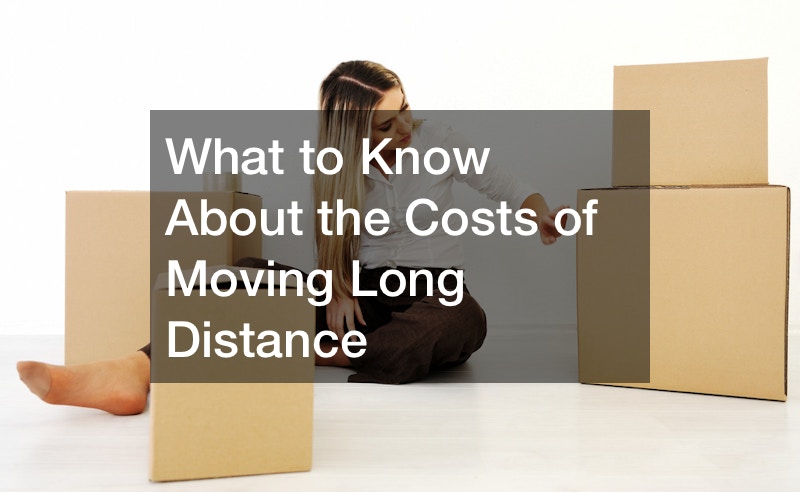
Moving long distances can have many benefits, from new job opportunities, broadening your horizons, and allowing your family to settle in a new place. However, long distance moves also come with many challenges, the most significant being the costs. Unfortunately, moving expenses are unavoidable, although you can find several ways to save money. If you plan to move long distance, below is everything you need to know about the costs and tips to help you save money and enjoy a smooth move.
Budget for Your Long Distance Move
Moving long distances is an expensive undertaking. According to Angi, you can spend between $2,648 and $12,200 on a cross-country move. Of course, the further you move, the more you can expect to pay. Other factors will also affect your total moving costs, for example, the amount of goods you have.
Another thing to note during long distance moves is there isn’t a shortage of ways to spend money. Therefore, your moving costs can easily increase if you’re not careful, leading to overspending. To avoid this, you should create a budget for your expenses and strictly adhere to it.
One of the top items to budget for when moving long distances is the professionals you’ll use. Of course, this will include the long distance moving company you hire to transport your goods. Also, depending on your budget and preferences, you can hire other professionals like packers and home cleaners.
Packaging supplies are another moving expense you need to budget for. This includes boxes, tape, packing paper, plastic wrap, bubble wrap, cutting tools, labels, and markers. You can also spend on more supplies, for example, paying a pallet supplier for pallets to increase your packing efficiency. According to CostHelper, you can expect to spend between $50 (or less) and $300 (or more) depending on the supplies you invest in.
Lastly, storage is another expense to budget for during your move. You might need storage solutions to store your items until your new home is ready for occupation. Also, you can leave some things in your current location if your load becomes too large. Depending on your preference, budget, and the goods you’re stowing, you can hire an indoor or outdoor storage unit.
Plan for Your Move in Advance
Besides being expensive, moving long distances can be, at best, hectic and a nightmare at worst. The latter is a problem you’ll likely encounter if you have not planned properly. On top of that, a last-minute move is likely to be more costly, as you’ll not have enough time to research all the services you need to hire. Therefore, to enjoy a stress-free move, you should start planning early.
Once you’ve decided you’re moving and confirmed the location, the first thing to do is create a checklist. This should include everything you need to take care of before D-day and the acceptable timelines for completing them. The list can then serve as a roadmap to guide you during the planning phase, ensuring you don’t forget something critical.
Hiring a moving company is one of the top items to tick off your checklist. You can do this by contacting local movers for estimates and choosing the best offer. However, before deciding, you should confirm that the movers don’t have any hidden costs they have not quoted. In addition, you should ensure that the professionals you hire are licensed, insured, experienced, and have the necessary moving equipment, and most importantly, they have great reviews.
After choosing your movers, the next step is to reserve a date for relocation. When selecting the date, you must ensure that it leaves you enough time to check everything off your list. For example, you’ll need to have packed, disposed of everything you don’t need, made arrangements for pets, said goodbye to friends, etc.
Hire Moving Professionals
There’s no denying that moving with professionals will cost you money. However, moving long distance by yourself can be a terrible idea. After all, trying to handle everything yourself can be physically and emotionally overwhelming, leaving you with a horrible experience.
According to HGTV, household goods are easily damaged or lost during a move. Unfortunately, when moving by yourself, you’ll bear such losses, whereas a professional relocation will be covered by insurance. Therefore, working with professionals is the best decision you can make during a long distance move.
One of the top services you can hire when moving long distance is transportation, the basic service offered by moving companies. It’s a vital service, ensuring that your belongings are moved professionally, with care, and covered by insurance during transit. According to estimates by Moving.com, movers can charge between $1,442 ad $10,002 to transport goods for distances of around 1,000 miles.
Besides transportation, packing and unpacking are other vital services you can hire during a move. Using professional packers can help you save time and is less stressful. In addition, professionals tend to be more careful when packing, which can help protect your fragile goods from damage. According to HomeAdvisor, you can expect to spend between $380 and $3,600 on packing and unpacking, depending on the size of your home.
Junk removal and house cleaning are other vital moving services you can invest in. These can help you leave your previous home in perfect condition for the next occupant. According to Angi, a move-out cleaning can cost between $120 and $420.
Sell the Items You Don’t Need
Selling your items before a move is a great way to declutter and get rid of everything you won’t need. It can also be a way to start afresh; you can sell old items and replace them once you settle in your new home. According to Realtor, selling your stuff before moving long distances could save you money and provide you with funds for your moving costs.
When packing for a long distance move, you can find many unwanted, unused, or underused items you can dispose of. Some top ideas include kitchen appliances, books, older electronics, clothes, linens, towels, old furniture, power tools, sporting goods, and more. You could also sell some of the items you need or use regularly and replace them once you reach your new home. This can help you to decrease your load and, consequently, moving costs, thus saving you money.
As for where to sell your items, several options exist, starting with a garage sale to dispose of everything. You could also sell electronics, jewelry, and antiques to a pawn store. Another excellent idea is to sell to family, friends, colleagues, and neighbors. Alternatively, you can advertise your stuff online, where you might even land better deals.
What about your home? If you’re asking, ‘Should I sell my house before moving?’ The answer might be yes. First, selling will give you the capital to buy a new home and possibly cover some of your moving costs. In addition, attempting to rent out your property when moving far away might present several challenges, which you might be better off avoiding.
Find Ways to Save on Your Moving Costs
Unfortunately, the costs of moving long distance can quickly add up. This can severely deplete your financial resources or leave you with a moving bill you cannot afford. Fortunately, you can avoid this by finding creative ways to save money during the move.
Of course, selling your item will be one of the top ways to make and save money. But, then again, you don’t want to sell everything you own, as you must purchase them back in your home. This could lead to even more expenses, as you will spend more (than you made during the sale) on your new stuff.
Packing is another top area where you can save money during a move. For example, you could pack your belongings instead of hiring professional packers. Alternatively, you could take advantage of free packing labor from your family and friends, thus reducing your moving costs.
Avoiding hidden costs is another top way to keep your expenses low when moving long distance. According to Angi, some of the most common hidden moving fees include tipping movers, disassembly and assembly of furniture, packing supplies, hauling heavy items, and express shipping. So, you need to either avoid services that can lead to extra fees or properly budget for them to avoid unexpected expenses.
Lastly, you can save money on your move by relocating during the off-season. According to Architectural Digest, off-peak moving months start around September until April. During these months, you can get better deals from moving companies, saving you much money. And as a bonus, you can enjoy more flexibility in the moving schedule.
Get Your Car Ready for the Move
When moving long distance, your household items are not the only ones that need relocation; you and your family must also make moving arrangements. And one of the best ways to do this is by traveling in your car. However, this means that you must also prepare it for the long distance journey, lest you experience problems on the road.
One of the top ways to prepare your vehicle for a long distance move is with a car inspection. An inspection can detect issues with your vehicle, allowing you to fix them before you get on the road. Consequently, this will prevent a situation where your car breaks down during the move or, worse, gets into an accident.
After your vehicle’s inspection, you should hire the necessary auto repair services to fix any identified issues. Some top problems to pay attention to include the brakes, suspension, tires, transmission, engine, lights, steering, fuel system, etc. Besides repairs, you can also give your car a tune-up, for example, changing spark plugs, replacing filters, and changing or topping off the fluids. These tune-ups will help ensure the vehicle is ready for the demands of the long distance move.
Another way to get your car ready for a long distance move is to ensure it’s comfortable. For example, you should check that the AC is working, especially if you plan to move on a hot day. You should also equip your car with the necessary comfort features like an entertainment system and chargers for everyone’s electronic devices.
Plan for Your Arrival at the New Home
According to a survey by One Poll as reported by New York Post, relocating is one of the most stressful events in life — even more than a breakup or divorce. Therefore, moving long distances is likely to be a physically and emotionally exhausting experience. And unfortunately, the experience can be worse if you find that your new home is not ready when you arrive. As a result, when planning your move, you must also prepare for your arrival to ensure it’s as stress-free as possible.
One of the top ways to prepare for your arrival in the new home is to ensure that it’s in perfect condition – clean and doesn’t need any repairs. Unfortunately, this can be hard to achieve during long distance moves. As a result, you might need to visit your home beforehand or coordinate its preparation with a trusted friend or real estate agent.
Turning on your utilities is another top way to prepare your new home for your arrival. After all, there’s nothing as stressful as arriving at night only to find no running water or electricity. So, this is another critical area you shouldn’t overlook when planning your move.
Alternatively, if your home is not ready, you should make proper arrangements to accommodate your family and household belongings. Unfortunately, this may incur additional costs in terms of hotel accommodation and storage fees. Therefore, remember to budget for these expenses or delay your move until your home is ready.
Moving long distances can be an expensive and daunting undertaking. Without a proper plan, it can go wrong quickly, turning your relocation into the stuff of nightmares. However, with the above information and tips, you can plan for a successful, smooth, and more budget-friendly, long distance move.







